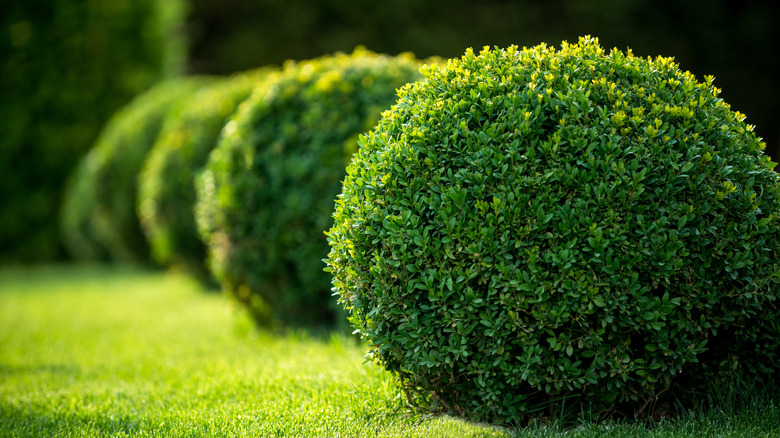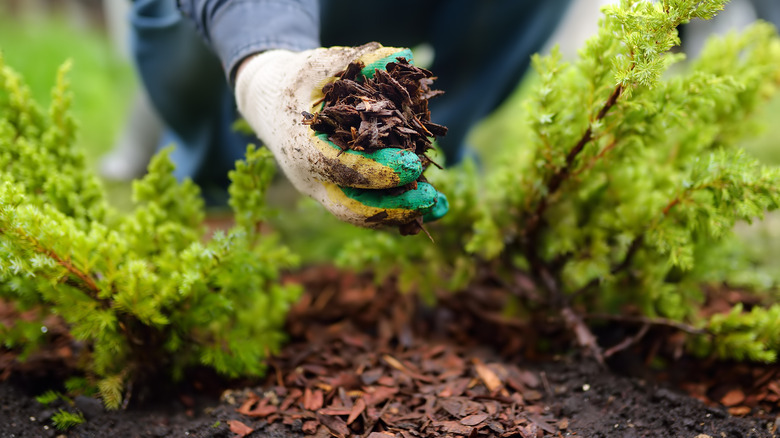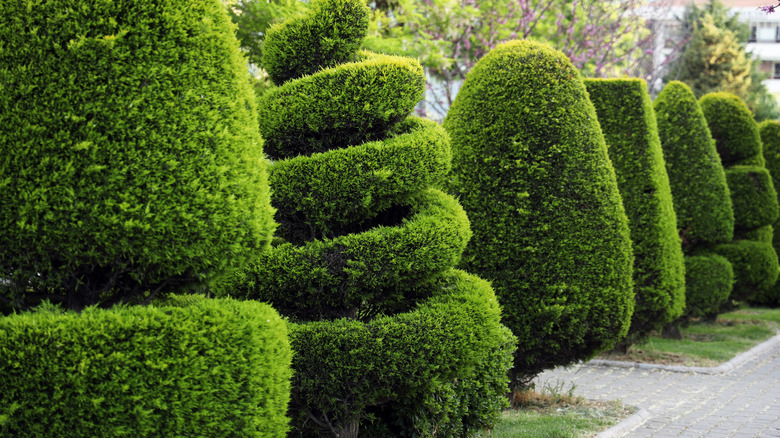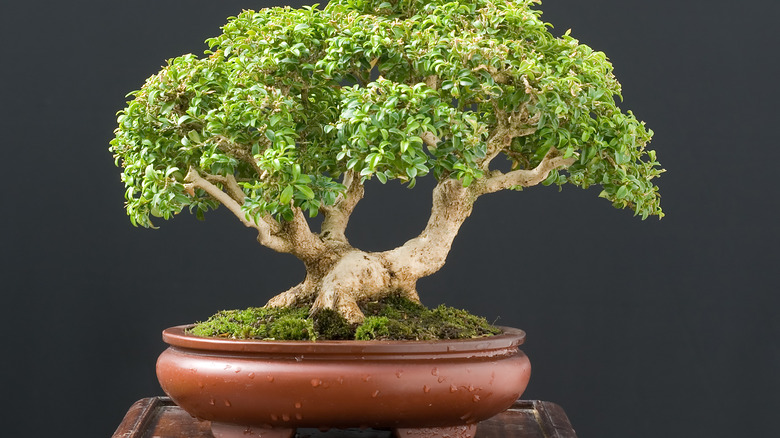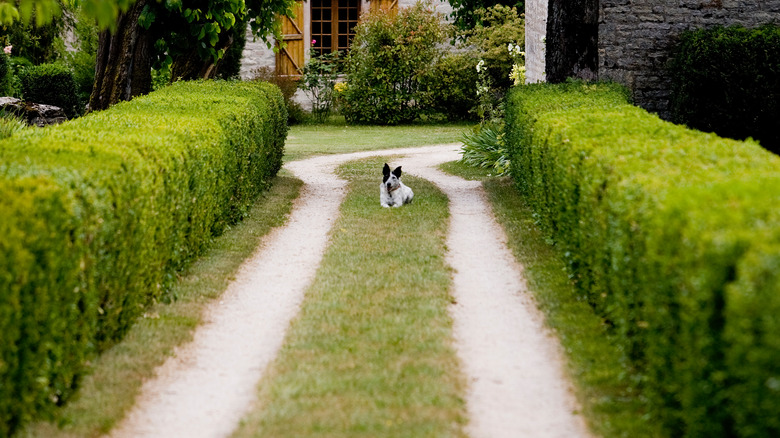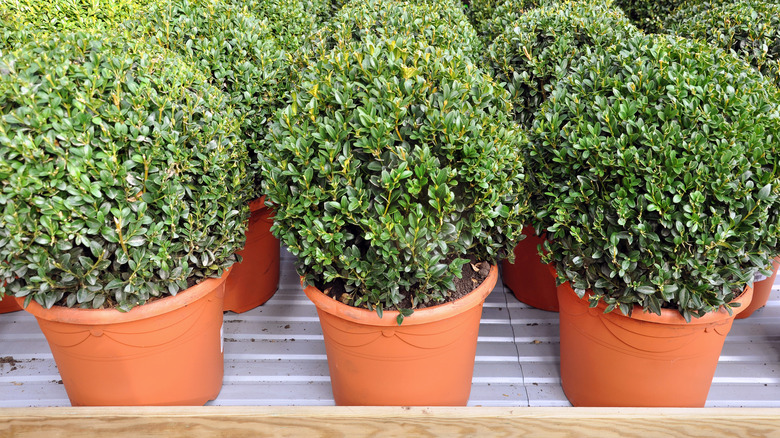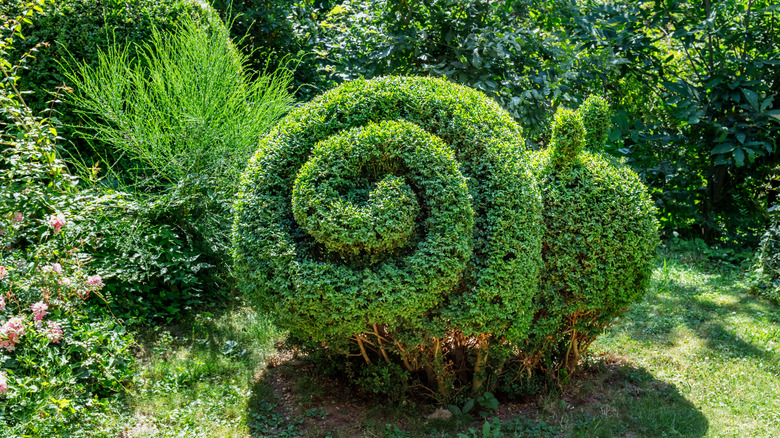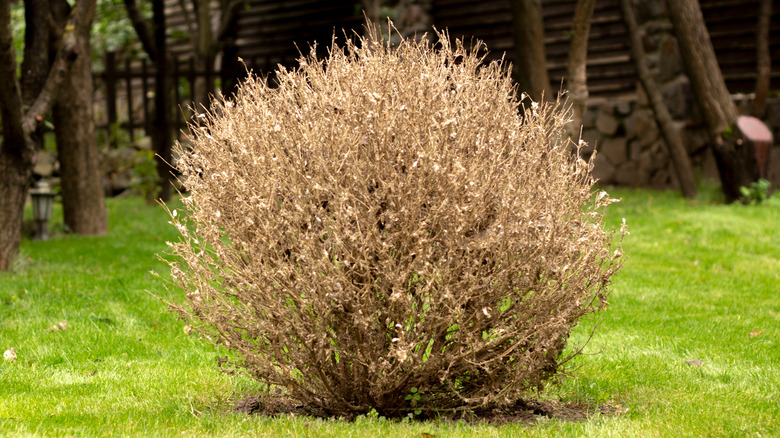How To Care For A Boxwood Shrub
Hardy, shapeable, and tolerant to both sunny and shady conditions, evergreen boxwood shrubs are one of the most popular plants used in landscaping. They are slow growers that take well to any area in your garden. They also make great options for containers and will tolerate a wide range of soil types. Buxus is the genus name for this plant, with close to seventy species in the Buxaceae family. Still, Buxus sempervirens (always green) is the common type found in gardens all over the United States. It is colloquially known as both the American boxwood and the European box. NC State's Extension Gardener Plant Toolbox classifies the boxwood as low-maintenance due to its ability to thrive in all conditions.
Another reason these are a favorite among landscapers and garden designers is how creative you can get when shaping them. Boxwood shrubs have thick foliage covering all sides. As such, they can be trimmed into perfect spheres, molded into impenetrable walls of greenery, or pruned into fanciful shapes of all sizes that will delight your visual senses and add a playful energy to any landscape.
How to use a boxwood shrub in garden
As mentioned, two of the most alluring factors of boxwood shrubs are their evergreen status and just how shapeable they are. They can be planted as hedgerows and left to sprout up to 20 feet tall. Choose an American variety to reach that height where they will gorgeously partition off walkways and work as privacy barriers. Alternatively, as described in Southern Home Magazine, traditional parterre gardeners keep boxwoods trimmed low and tight to create borders around flower beds. Used in this way for definition, boxwood shrubs offer a lovely and living botanical framework to extensive garden landscapes. Popular in the 15th, 16th, and 17th centuries, parterre gardens can still be found in preserved European castles. They've since made their way to the United States as well.
Boxwoods can also be individually planted and pruned into all kinds of fun shapes and sizes, from pompoms to exotic animals. Japanese boxwoods are the go-to variety for ornamental topiaries because they stay compact. Leaf growth is tight, giving them a flushed-out and showy green effect on all sides. Their slow growth makes it easy to maintain even the most intricate designs. The best part is they stay green year-round, offering bursts of life and color in even the dreariest months.
How to grow a boxwood shrub
Add boxwoods to your garden in the fall or spring. Proper drainage is very important for these plants, so you'll need to prepare the soil before planting. Dig a hole considerably larger than the original pot it comes in. A good tip from SFGate is to use ground pine bark as a soil conditioner. This will not only provide nutrients from organic matter, but it will also encourage aeration and water flow. Pine bark pieces around ¼-½ inch big will do the job best.
Since boxwoods are very prone to root rot, which will cause leaves to brown and fall off, it's important to keep the roots of your shrub shallow. When your soil is ready, take care not to place the rootball too deep. If t the hole is still too large, add more soil and pine bark, mix well, and try again. The part of the trunk where the roots spread out, known as the crown, can remain 1 inch above the soil. An established boxwood will be drought tolerant and only require watering during long stretches of dry conditions. Boxwoods are also very easy to propagate by simply cutting off a 6-inch piece and planting the cut side into sandy soil. Do this during the summer months, and your new plant should be ready to return to the ground by fall.
How to care for a boxwood shrub
Summer is the time to tend to your shrubs, and boxwoods do require regular pruning. Left to their own growth habits, their foliage can become so dense that the leaves on the inner branches will be completely blocked from sunlight. Pruning also helps keep fungal infections at bay by improving air circulation. Bob Vila recommends switching between loppers and hand-pruners for this task. Loppers are larger and best for thick branches, and hand-pruners, also called pruning shears or secateurs, are basically gardening scissors. They fit in one hand and work well on thin branches, stems, and leaves.
Prune first for health, making sure to start by snipping off any part of the decaying or dead plant. When this is complete, go ahead and prune for shape. Stick to the hand pruners for a light touch. Take it slow, and don't forget to check your work as you go.
Boxwood shrub varieties
Per HGTV, while there are many members within the Buxus family of boxwood shrubs, they primarily come from four distinct regions: America (sempervirens), England (sempervirens 'Suffruticosa'), Japan (microphyla), and Korea (sinica). Varieties differ in leaf shape and color, growth rate, and density. Typically, the American varieties grow the fastest and tallest, making them the prime option for large hedgerows. English varieties are more compact and shapeable, so they are better for ornamental topiaries and low to the ground borders. The fastest growers who can also handle very cold weather, including frost, are the Asian varieties.
There is also the boxwood bonsai. Pictured above, this is an outstanding starter plant for the novice or mistake-prone bonsai cultivator. It can be styled and trimmed regularly in practice sessions and is expected to bounce back each and every time. According to the Bonsai Resource Center, one of the best options for a bonsai is the Chinese boxwood. This plant is equally as hardy as the other varieties, yet perfect as a bonsai because of its more delicate nature.
Is the boxwood shrub toxic?
Boxwood shrubs are safe to touch and would only cause concern to humans if they consumed the plant, which is unlikely to happen. However, all shrub parts contain buxine, cyclobuxine, and cycloprotobuxine alkaloids; those are poisonous to animals when ingested, Pet Poison Helpline notes. In cats and dogs, symptoms tend to stay mild because the bitter taste of the alkaloids usually convinces them to stop eating. Still, if the taste does not deter your pet, a general stomach upset will likely occur and could potentially turn into vomiting and diarrhea.
Pet Poison Helpline warns that in the case of excessive consumption, this shrub is severely toxic to horses, cows, and other livestock as well. Persistent gastrointestinal symptoms may advance to dehydration. In rare cases, seizures and death have been recorded. Keep boxwood plants away from any farm animal enclosures, and call your veterinarian if your dog or cat has been seen munching on this shrub.
How to repot a boxwood shrub
With dense foliage and shallow roots, the boxwood shrub can tolerate regular repotting, and a terracotta pot makes a great choice for your trimmed topiary. Terracotta dries out faster than other materials, ensuring your boxwood shrub is never sitting in wet soil. Go big when choosing an appropriate container. Per Gardening Know How, you want the width of the pot to match the height of the plant. Most likely, the perfect size pot is the widest one you have.
Furthermore, thorough drainage is key to healthy boxwood. Extra holes can be drilled into pots if needed. Also, use a well-draining and sandy, or loamy, potting soil. Once potted, maintenance is easy. New plants will need a little extra water when just starting out, but watering can be slowed down considerably as they age. Fertilizing a boxwood once per year is sufficient; do so in the fall with a 10:6:4 formula. Keep in mind, though, that these plants prefer nitrogen, and magnesium will enhance foliage color.
How to shape a boxwood shrub
Shaping a boxwood shrub is an age-old art form unto itself. Master gardeners worldwide have molded hedgerows and topiaries into unique sculptures, and hobbyists can join in on the fun as well. Gardeners' World advises you to get started in early spring and cut slowly with various cutters for different angles and shape needs. Sharpen your blades to avoid crushing and damaging stems. Leaving darker, older growth untouched, start by trimming back newer, lighter green leaves. Trim with intention until the basic shape you're aiming for can be seen. Patience is a virtue, as it'll be much easier to keep making small cuts than fixing a major misstep. Take the time often to check your progress.
For intricate designs, consider first building a mold out of chicken wire. Place the finished mold over the plant and pull the branches and stems through its holes. From there, keep your cutters horizontal to the angle you want each branch cut. Snip back to the wire as you form the desired shape. Have fun with it, and before you know it, you'll have a garden full of spirals, snails, and any other shape that strikes your fancy.
Boxwood shrub diseases
There is a fungal disease particular to this family of plants called boxwood blight. The fungus attacks the trunk, stems, and leaves. The first sign of the blight is dark yellowish spots on the leaves. This will be quickly followed by the leaves at the bottom of the plant falling off and darker streaks appearing on the stems.
Boxwood blight is tricky to get rid of because fungal spores on fallen leaves are hard to kill. In warm weather with high humidity, those spores can multiply and spread by seeping into the soil or sticking to just about anything. Affected plants will need to be removed and destroyed. And be sure to keep the debris far away from your compost pile. Missouri Botanical Garden lists a few varieties that have been cultivated specifically to be less susceptible to this blight, including B. harlandii, B. microphylla 'Golden Dream', B. microphylla 'Wedding Ring', B. microphylla var. japonica 'Green Beauty', and B. sinica var. insularis 'Nana'.
